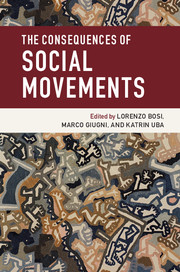Book contents
- Frontmatter
- Contents
- List of figures
- List of tables
- List of contributors
- Introduction
- Part I People
- Part II Policies
- Part III Institutions
- 11 The impact of social movements on political parties
- 12 Watershed events and changes in public order management systems: organizational adaptation as a social movement outcome
- 13 The institutionalization processes of a neo-Nazi movement party: securing social movement outcomes
- 14 Incorporation and democratization: the long-term process of institutionalization of the Northern Ireland Civil Rights Movement
- Conclusion
- Index
- References
12 - Watershed events and changes in public order management systems: organizational adaptation as a social movement outcome
from Part III - Institutions
Published online by Cambridge University Press: 05 January 2016
- Frontmatter
- Contents
- List of figures
- List of tables
- List of contributors
- Introduction
- Part I People
- Part II Policies
- Part III Institutions
- 11 The impact of social movements on political parties
- 12 Watershed events and changes in public order management systems: organizational adaptation as a social movement outcome
- 13 The institutionalization processes of a neo-Nazi movement party: securing social movement outcomes
- 14 Incorporation and democratization: the long-term process of institutionalization of the Northern Ireland Civil Rights Movement
- Conclusion
- Index
- References
Summary
Research on protest policing has become an important niche within social movement studies. There is widespread acknowledgement in this field that police strategies and tactics are in part an adaptation to contemporary forms of protest and that this adaption has occurred through a process of tactical interaction and gradual institutionalization of different forms of protests (Combes and Fillieule 2011). However, thus far police organizational adaptation has not been explicitly framed as a type of social movement outcome. The argument in this chapter is that analyzing police organizational change in response to protest events as a social movement outcome contributes to a better understanding of both consequences of social movements and developments in protest policing.
Research on social movement outcomes has previously focused on political, cultural, and biographical outcomes (Giugni 2008). Outcomes regarding changes in institutionalized organizational practices do not fall neatly into any of these categories and have received considerably less attention (for an exception, see Zald et al. 2005). Furthermore, this type of social movement outcome is largely unintended (Tilly 1999). It is related less to the substantial demands and framings of social movements than to the “repertoires of action” (Tilly 1978) associated with movements and protest campaigns.
Historically, government interest in suppressing violent protests during the early to mid-nineteenth century played a significant role in the development of the modern police force. In Britain, concerns about riots and social disorder were used to justify the creation of modern police forces (Reiner 1998, 2000). Similarly, in Sweden the failure of the city guards to contain the March 1848 riots in Stockholm, which resulted in the death of eighteen protesters, constituted a tipping point in a process that led to a modernized Stockholm city police authority (Furuhagen 2004). Presumably, it was not only fear of a popular uprising among the ruling class that contributed to such events. Compared to most other police tasks, large-scale public order policing is a generally far more public and direct measure of police performance. Crowd control failures are difficult to conceal and likely to lead to criticism and political pressure for reform.
Later examples of the impact of protests on police organizations include the development of a “negotiated management” approach to protest policing in response to protests during the late 1960s and early 1970s (McCarthy and McPhail 1998).
- Type
- Chapter
- Information
- The Consequences of Social Movements , pp. 285 - 313Publisher: Cambridge University PressPrint publication year: 2016
References
- 2
- Cited by



